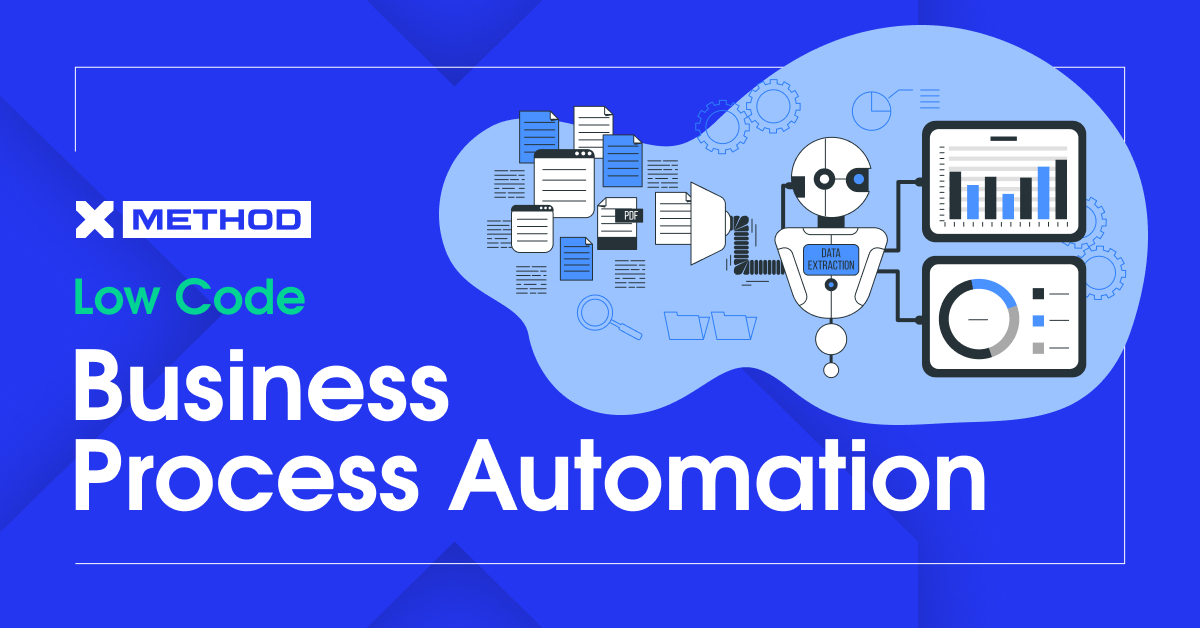How Low Code Business Process Automation Is Changing the Game for Companies

The practice of automation has shifted from being nonessential to becoming mandatory. The attention of business owners should focus on low code business process automation to accelerate their processes, especially if they choose to avoid expensive months-long development projects.
After reading this article, you will learn:
- Principles of work of this development method and what makes it unique compared to other strategies.
- How low code enables process automation with clear, easy-to-follow steps.
- Which platforms work best?
- How to apply it in practice — from HR to logistics.
- How AI and trends like citizen development influence automation's evolution.
Contents of the article:
- What is Low Code?
- Advantages of Low Code for automation
- How automation works with Low Code
- Examples of automation in different areas
- Comparison with other approaches
- The future of low code business process automation
The following article is for entrepreneurs, analysts, managers, and anyone who wants to understand how to simplify and speed up technology-driven change.
Why You Can Trust Me
My name is Jasper. I have provided automated process solutions to businesses for more than ten years. Over the past years, I have helped to implement this type of coding to different organizations, including startups and major enterprises.
I’ve worked with different tools — not just in theory, but in real projects.
I know where the bottlenecks are, how to overcome them, and what approaches can build automation that helps, not hinders. Everything I share in this article is personally tested.
Let's go?

What Is Low Code?
I swear, when I heard the definition “low code”, I thought that IT professionals used it as a temporary trend. However, my deeper investigation revealed it to be a real revolution.
Definition of Low Code
Let me try to explain what I mean by low code automation.
Now you can digitize procedures without an army of programmers — everything is done in a visual interface development method based on drag-and-drop actions, but with elements of manual coding.
The user obtains functionality through blocks containing prewritten code during movements within a low-code development environment.
Does this remind you of something? Yes, it is very similar to a children's construction set. Therefore, low coding is, simply put, a visual construction set in which you assemble a system from blocks.
Differences from Traditional Development and No Code
Based on the definition, you probably already understood that the main difference here is that in traditional programming, you need to describe each step manually. Of course, this does not exclude the fact that programmers use templates even in this case, but they still write most of it themselves.
The opposite in this regard is no code. No Code does not require code from the programmer at all, but it also has less flexibility.
So, what is low code automation? It is the golden mean. To summarize, you can configure almost everything yourself from ready-made blocks. But if you need something special, add code.
Examples of Popular Low Code Platforms
No-code and low code automation platforms have an intuitive interface, and each element for visual layout is already written. The developer only needs to select the blocks he needs - text, graphic elements, registration forms - and place them on the page. The program code will automatically adjust to this structure.
Here are a few platforms that I have worked with personally:
- OutSystems - great for large solutions.
- Mendix - easy to learn, great integration.
- Appian - well-suited for corporate automation.
- Microsoft Power Apps - ideal for the Microsoft ecosystem.
They all bring something special to the table, so it’s important to choose the one that suits your business.
Key Features and Benefits
Thanks to low code business process automation, you may:
- develop interfaces without a designer;
- describe process logic visually;
- build integration with CRM, ERP, databases;
- quickly make changes as you go.
This is real freedom for business.
Benefits of Using Low Code for Automation
What forces various enterprises to adopt this approach? The answer is simple: benefits.

Speed of Development and Implementation
You probably think that the implementation takes months. Well, now it takes weeks, and sometimes days.
A pilot can be launched literally in a weekend.
Cost-effectiveness
Fewer developers = lower costs. In times when all companies are trying to optimize as much as possible, this development model allows you to save on labor, after all, most of the actions can be done by one person.
Another point in this category is a quick response to market changes. This is especially nice if we are talking about development today, in times of a reactive market, when any day can turn everything upside down.
Increased Flexibility
We all strive for agility. This type of development brings us closer to it at the speed of a supersonic jet, because thanks to this type of development, we can make some changes every day.
Need to change a stage in a business? A couple of clicks.
Add a new rule? A few minutes.
This is especially valuable in unstable conditions. Competition in the IT industry forces companies to quickly make decisions based on the current situation, low coding helps boost processes.
Accessibility for Civilian Developers
You don't have to be a programmer. Every member of a team (even HR) can create solutions themselves using ready-made templates and blocks, which are tools in this type of programming.
This is real digital transformation. This is what I was talking about at the beginning of the article when I mentioned the revolution.
Reducing the Number of Errors
Less code = fewer bugs. And visual schemes are easier to test and understand.
Let's just remember the following case.
The Mariner 1 research probe conducted its mission to Venus on July 22, 1962. But it didn't have to fly for very long - four minutes later, the flight safety officer had to give the command to self-destruct due to a dangerous maneuver and deviation from the specified course.
Unfortunately, self-destruction was necessary. Analysis after the flight identified that an absent hyphen in computer code within the data editing program caused the wrong flight guidance signals to be transmitted.
The probe is not cheap, you know. Someone in the team was having a bad day.
Of course, today you probably won’t set up a research probe for a flight into space with the help of low coding only. But everything is improving - perhaps one day we will be able to do this.
How Does Business Process Automation Work with Low Code
Using my projects as an example, I will tell you how routine tasks were automated in my company using this type of development.

Analysis of Current Workflows: Mapping and Identifying Bottlenecks
When a new project comes to me, I ask to show me the structure from the point of view of processes. And the more detailed the structure is described, the easier it will be to analyze it and identify those areas where improvement is needed.
First, I conduct an analysis: where is time lost? Where are the bottlenecks?
In one of the projects, it turned out that manual data entry eats up hours every day - this is a fairly common situation even in the largest and most innovative companies.
The "bottleneck" method is aimed at identifying bottlenecks in business that slow down or hinder the achievement of the company's goals. The main idea is to identify the stages or resources that are limiting factors for the execution of the task as a whole.
For that project, I drew a diagram: from the client's application to the final document.
Low code platforms provide algorithm visualization as a key feature by displaying the hidden coding elements as diagrams. Through algorithm visualization all stakeholders use the same language to understand the process diagram.
Building a Solution on a Low Code Platform
When everything became clear, I moved on to building a solution. I usually use a system that consists of three simple steps.
- Creating interfaces. For convenience, I created a form in which the manager enters the client's data. Everything is done via drag-and-drop, that is, without using a single line of code.
- Configuring the logic of business processes. Management and I explained standard operating procedures applicable to any employee who uses the form. Simple example of such a rule: an automatic notification goes to the manager while the system generates the contract when a VIP client uses the system.
- Integration with other systems (ERP, CRM, etc.). Synchronization with CRM was a must. We simply connected the API and specified what data to transfer.
And everything worked right away.
Integration capabilities of this development method help automate routine data transfer work, facilitate and unify employee access to other systems. That is, data exchange between different IT systems significantly simplifies the digital transformation of business.
So, this method shortens the application development cycle. The stages of architecture planning, choosing a development environment, creating prototypes, analyzing UX, and others are excluded, since all of the above is already implemented in the Low-code platform.
Implementation and Testing
After setting up, it is necessary to conduct tests to see any shortcomings. Since the system is easily reconfigured, all the nuances can be fixed in the shortest possible time based on the wishes of all participants.
On our project, I launched a test for 5 users. Collected feedback. Improved.
And a week later, we included everyone.
Through this development type, enterprises can eliminate system design stages and development periods before reducing dependency on external development contractors. The system provides the business unit with the ability to independently design and implement its tasks.
Employee Training and Support
We trained the employees in a day, because the interface is as simple as possible, and everything is intuitive.
My advice to you is to take the time to watch video instructions. This is always easier and faster, especially when it comes to working with a large company where the number of people is constantly growing or there is staff turnover.
Some companies also implement a support chat. A competence center for the use of the low-code platform can be allocated within the company.
Examples of Automation with Low Code
Here are a few more cases where low code workflow automation works wonders.

Sales Management
Sales management can be both a key feature in a company and a part of individual projects. Usually, this is a standard task and, accordingly, it can be described, automated, and optimized.
For example, the system automatically distributes leads among managers, taking into account their workload and specialization. Plus, you can set up automatic reminders about calls and deadlines.
The composition of participants, document forms, and workflow can be changed using the appropriate low-code frameworks. The ability to track communication with clients, not lose them, conclude transactions faster, and improve operations increases the efficiency of a department or the company as a whole, if this process is key.
HR Processes
New employee onboarding can be automatic. Everything from a welcome letter to creating an email and password.
When hiring, tasks are created for IT, accounting, and the manager, all according to a template. If an employee quits, the platform itself generates a checklist for the exit.
In addition, it became possible to collect feedback through built-in questionnaires. This helps improve work and the adaptation of newcomers.
Financial Accounting
Automatic generation of acts, invoices, and their sending to clients. Reduction of errors and manual work several times.
Imagine that the system checks the correctness of the details, controls payment terms, and notifies those responsible about delays. All documents are stored electronically and are available from your account.
You can even add automatic reconciliation with the bank. This will speed up the closing of the period and reduce the number of discrepancies.
Logistics and Warehouse
Inventory, balance accounting, delivery routes — everything can be in one system. Plus — notifications about product shortages.
When a product runs out, the system sends a notification for purchase. Couriers receive routes via a mobile application. Drivers mark delivery statuses directly from their phones.
Comparison of Low Code with Other Automation Approaches
Let's compare three approaches. Each is good in its way.
Traditional Development
Maximum flexibility and customization. With its help, you can create super-complex systems that may be inaccessible in low coding.
High loads, custom integrations, and security - these tasks require qualified engineers and cannot be fully solved by visual programming, which is focused on solving typical problems.
When it comes to scaling an application, questions arise about containerization and clustering. If you can't meet the load requirements with low-code or no-code solutions, then custom development will be needed.
But it is expensive and time-consuming. Any change = a week of work or more.

No Code
It is as fast and simple as possible, and you may not need any knowledge of a programming language at all.
This development tool is ideal for creating an MVP. In case of a pivot, it will not be a pity to throw away the product and rebuild a new one.
But it is limited.
If your business needs a non-standard process, it will be difficult.
Nocode is well-suited for business applications and processes, but if you want to create something high-tech (like a blockchain project, a messenger, or a complex SaaS), it will not be the best solution.
If your service scales to tens of thousands of users, then in any case, you will need to connect to conventional development. But this should be done gradually and in stages, along the path of growth.
That is why low code process automation is called a balance between flexibility and speed. For 80% of tasks, it is ideal.
The Future of Low Code in Business Process Automation
I truly believe this approach is the way forward, especially with AI getting smarter every day. So, as a result, there are also emerging trends within this industry.
The Role of Artificial Intelligence and Machine Learning
Low code platforms are already embedding AI.
What exactly can they be used for?
- sales forecasting;
- customer behavior analysis;
- automatic request classification.
The current stage indicates the initial phase of these developments. The pace of human relations with AI systems continues to increase rapidly.
The process of identifying abnormal patterns in data becomes possible through machine learning capabilities. For example, suspicious transactions or failures in logistics.
AI systems provide automatic recommendations for business process optimization steps. The system can suggest the most appropriate communication channel while also determining the stage at which the potential client drops out.
What other examples of interaction are there?
Low-code platforms use AI and machine learning to give you helpful tips for building apps, find areas that need improvement, and keep an eye on how things are going. For example, systems can analyze user behavior and automatically suggest improvements in the interface or functionality, which significantly improves the user experience.
Generative AI technology exists on some platforms while also creating its own automated logic for specific tasks based on description inputs. This makes development even easier.

Trends: Hyperautomation, Citizen Development
Hyperautomation is not just a buzzword. It is the unification of all low code automation technologies into one ecosystem.
Hyperautomation with these platforms permits organizations to concentrate on challenging assignments because it performs regular operations automatically. The business achieves better efficiency through reduced task completion times when using this approach.
Do you want to develop something new at work? Citizen development is all about giving everyone the ability to create, without needing to be a professional developer. Low code automation is the foundation here.
This movement is all about making development accessible to everyone, giving more employees the chance to help automate processes and tackle business challenges.
With these tools, everyday users can create apps tailored to their industry and customized to meet their company’s specific needs. This means that they can initiate projects themselves that are aimed at optimizing business processes, which reduces waiting time and increases the speed of response to changes.
Why does this make work easier?
Ordinary employees or department heads know the processes better. Every day, they may face the same tasks and see the potential for automating routine tasks, so the skill of creating their own solutions will help them simplify their work.
For this reason, employees who work with the same processes show more initiative in this direction. For example, HR managers and specialists in the sales department.
In Conclusion
When we speak about what is low code business process automation, we mean the approach that makes technology accessible to everyone. It allows you to quickly and flexibly adapt processes to business needs, reducing costs and errors. This is the future, and it is worth paying attention to today.




